AMD Ryzen 3000 release date, price, specs, and everything we know
Third gen Ryzen will bring 7nm, improved performance, and faster clockspeeds to AMD's CPUs

For the past decade or more, AMD has been sitting in second place in the CPU wars. It's not for lack of trying, and the past two years of Ryzen processors have certainly shaken things up in the competition to deliver the best CPU. Intel still managed to win in several areas—gaming in particular—but that could all change with the launch of the third generation Ryzen CPUs.
Using the Zen 2 architecture and with a leading edge 7nm process technology courtesy of TSMC, this is the first time AMD has ever had a manufacturing node advantage over rival Intel. This is huge, and it gives AMD a legitimate shot at the CPU throne. And not just for multithreaded workloads—we don't have independent numbers yet, but AMD could even come out ahead of Intel in gaming performance.
Here's everything we know about the features, architecture, price, models, specs, and release date of the upcoming Ryzen 3000 series.
Decoding codenames

All of AMD's current generation processors are based on some form of Zen, the name of its modern CPU architecture for every processor category—desktops, laptops, all-in-ones, servers, and so forth. While generally easier to follow than Intel's many different CPU architectures, it can still be confusing. Let's clear that up. Here are the versions of Zen, along with the corresponding codenames and desktop processor series:
- Zen ("Summit Ridge")—Ryzen 1000 series
- Zen+ ("Pinnacle Ridge")—Ryzen 2000 series
- Zen 2 ("Matisse")—Ryzen 3000 series
- Zen 3 ("TBA")—Ryzen 4000 series?
- Zen 4 ("TBA")—Ryzen 5000 series?
Zen 2 is actually the third iteration of the Zen microarchitecture, and is attached to AMD's upcoming Ryzen 3000 series. AMD's first-gen Ryzen processors (Zen) utilized a 14-nanometer FinFET manufacturing process. For the second-gen Ryzen parts (Zen+), AMD shifted to a 12nm node but with only minor updates to the architecture. The upcoming Ryzen 3000 series (Zen 2) processors are built on a 7nm node and contain significant changes to the underlying architecture along with the die shrink. Then in 2020 (most likely), AMD will launch its Zen 3 lineup, built on an enhanced 7nm+ node. Furthermore, AMD says Zen 3 is "on track" and that the subsequent Zen 4 architecture is currently "in the design phase".
I should note there are even more codenames than the ones above. What I've labeled are the names of AMD's mainstream desktop processors, but there also exist codenames for the company's CPUs with Vega graphics (essentially APUs, or accelerated processing units) and Epyc server chips. Further confusing the matter, the 2000 series APUs (eg, 2200G and 2400G) are first gen Zen architecture parts, and there are two new desktop APUs, the Ryzen 3 3200G and Ryzen 5 3400G, that are built using the second generation Zen+ architecture.
Ryzen 3000 series specs and pricing
AMD has officially announced six third generation Ryzen CPUs now, along with the two Ryzen 3000 desktop APUs. As anticipated after the first real glimpse of the processor at CES, Ryzen 3000 will come in two different varieties—and probably a third later once Zen 2 APUs arrive. I'll get into the specifics of why certain changes were made in a moment, but AMD now has a cIOD (client IO die) manufactured using 12nm, which consists of the memory controller and other aspects of the chipset. This in turn links to one or two CCDs—the actual Ryzen CPU cores and cache. The Ryzen 9 parts will have two CCD chips inside the package, along with the cIOD, while the Ryzen 5 and Ryzen 7 will have a single CCD. Here's what we know of the actual Ryzen 3000 lineup:
Keep up to date with the most important stories and the best deals, as picked by the PC Gamer team.
- Ryzen 9 3950X—16C/32T, 3.5GHz to 4.7GHz, 72MB cache, 105W TDP, $749 (in September)
- Ryzen 9 3900X—12C/24T, 3.8GHz to 4.6GHz, 70MB cache, 105W TDP, $499
- Ryzen 7 3800X—8C/16T, 3.9GHz to 4.5GHz, 36MB cache, 105W TDP, $399
- Ryzen 7 3700X—8C/16T, 3.6GHz to 4.4GHz, 36MB cache, 65W TDP, $329
- Ryzen 5 3600X—6C/12T, 3.8GHz to 4.4GHz, 35MB cache, 95W TDP, $249
- Ryzen 5 3600—6C/12T, 3.6GHz to 4.2GHz, 35MB cache, 65W TDP, $199
- Ryzen 5 3400G—(Zen+) 4C/8T, 3.7GHz to 4.2GHz, 6MB cache, Vega 11 Graphics at 1400MHz, 65W TDP, $149
- Ryzen 3 3200G—(Zen+) 4C/4T, 3.6GHz to 4.0GHz, 6MB cache, Vega 8 Graphics at 1250MHz, 65W TDP, $99
All of the above, with the exception of the 3950X, will launch on July 7—including the two second generation Zen+ APUs. There will likely be additional Ryzen 3000 parts, but this is what AMD has revealed so far. There may be lower price 4C/8T or 4C/4T Ryzen 3 models at some point, but those at least partially overlap the APUs and may not be necessary.
Pricing for the Ryzen 3000 parts is clearly higher than earlier rumors (guesses), and clockspeeds perhaps aren't quite as high as some had hoped. However, there's more to performance than clockspeeds, and power requirements are generally much lower than the competing Intel parts. Let's dig into some of the lower level details now to better understand what AMD has planned.

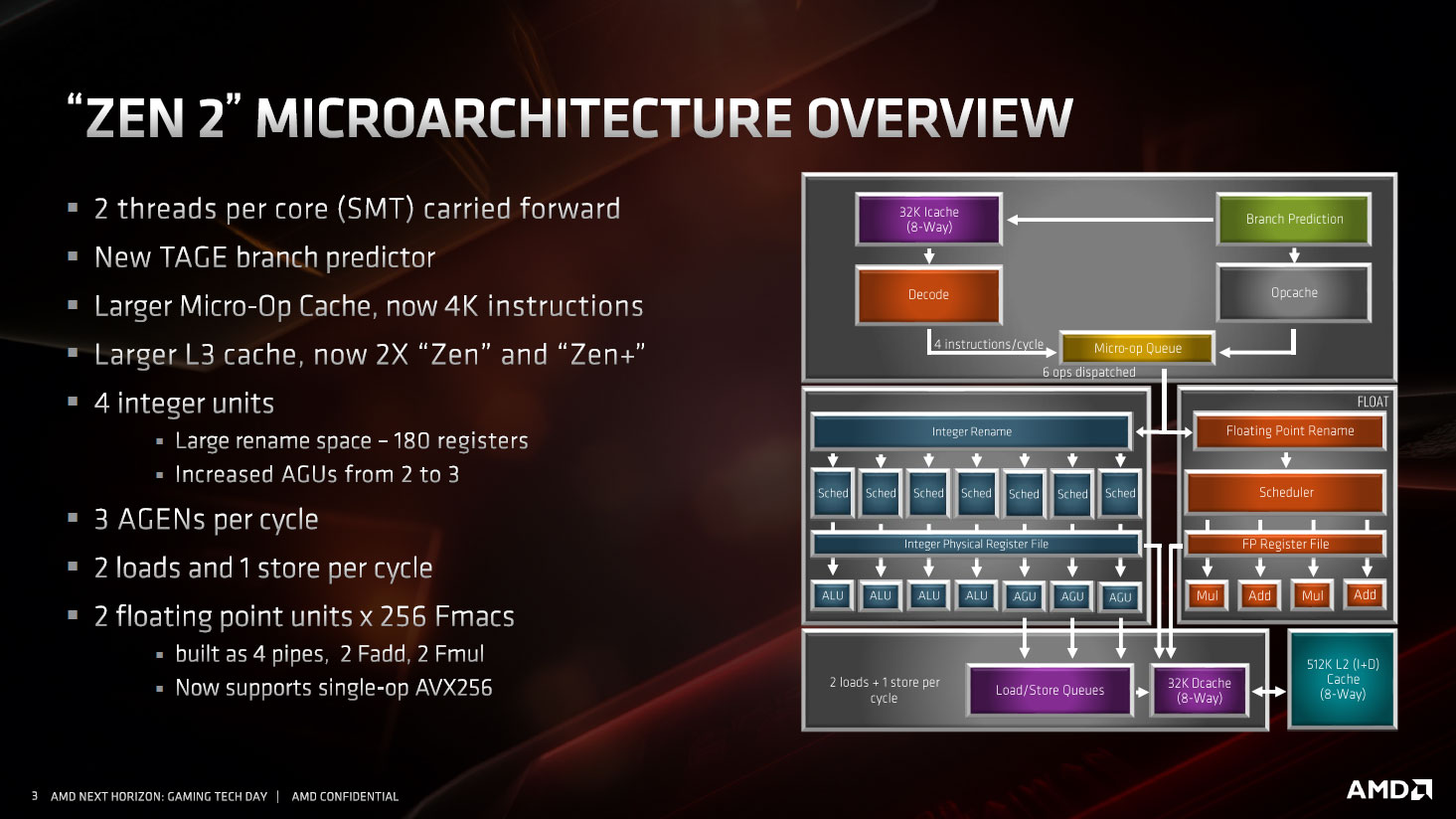

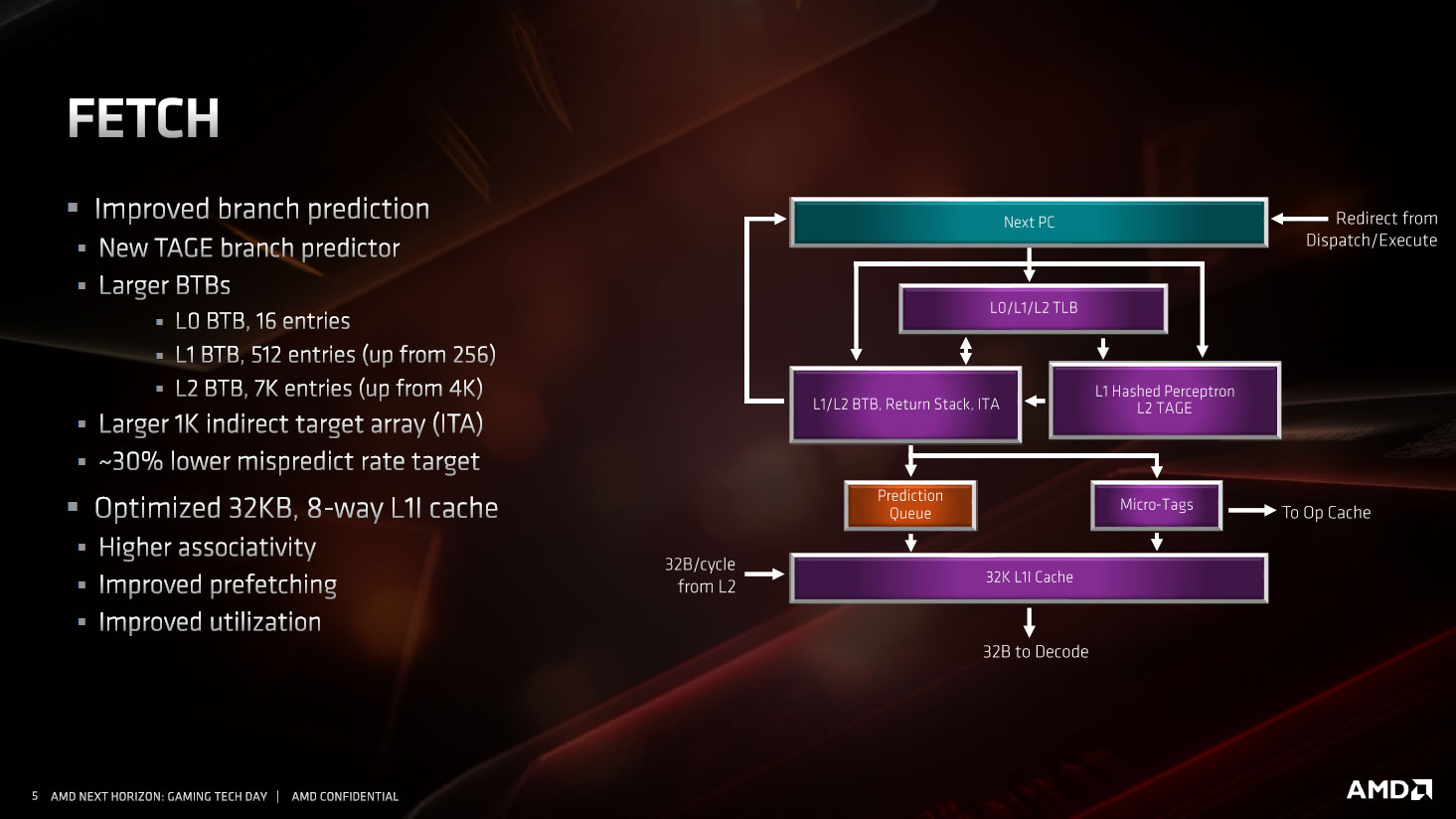
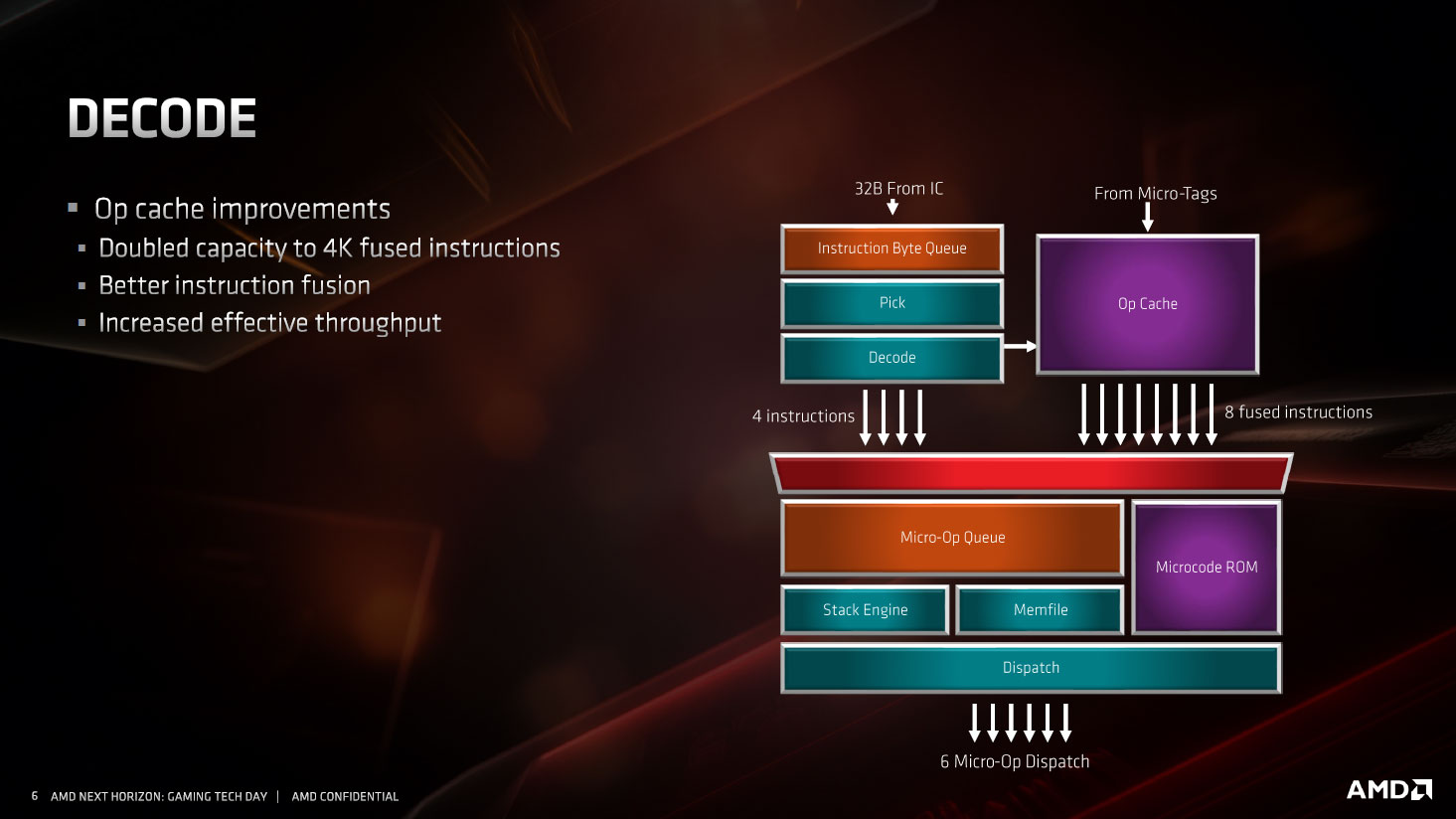
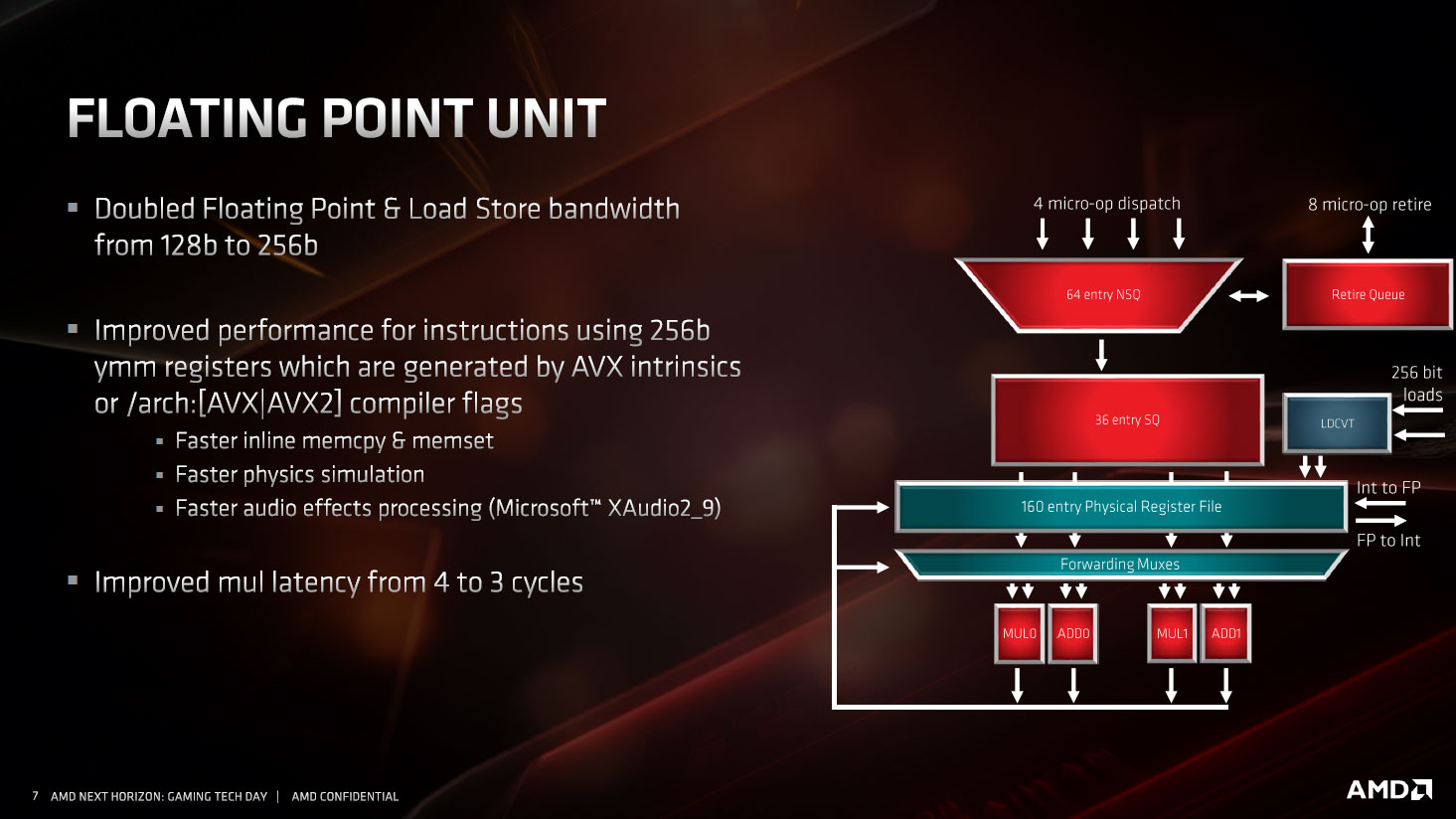
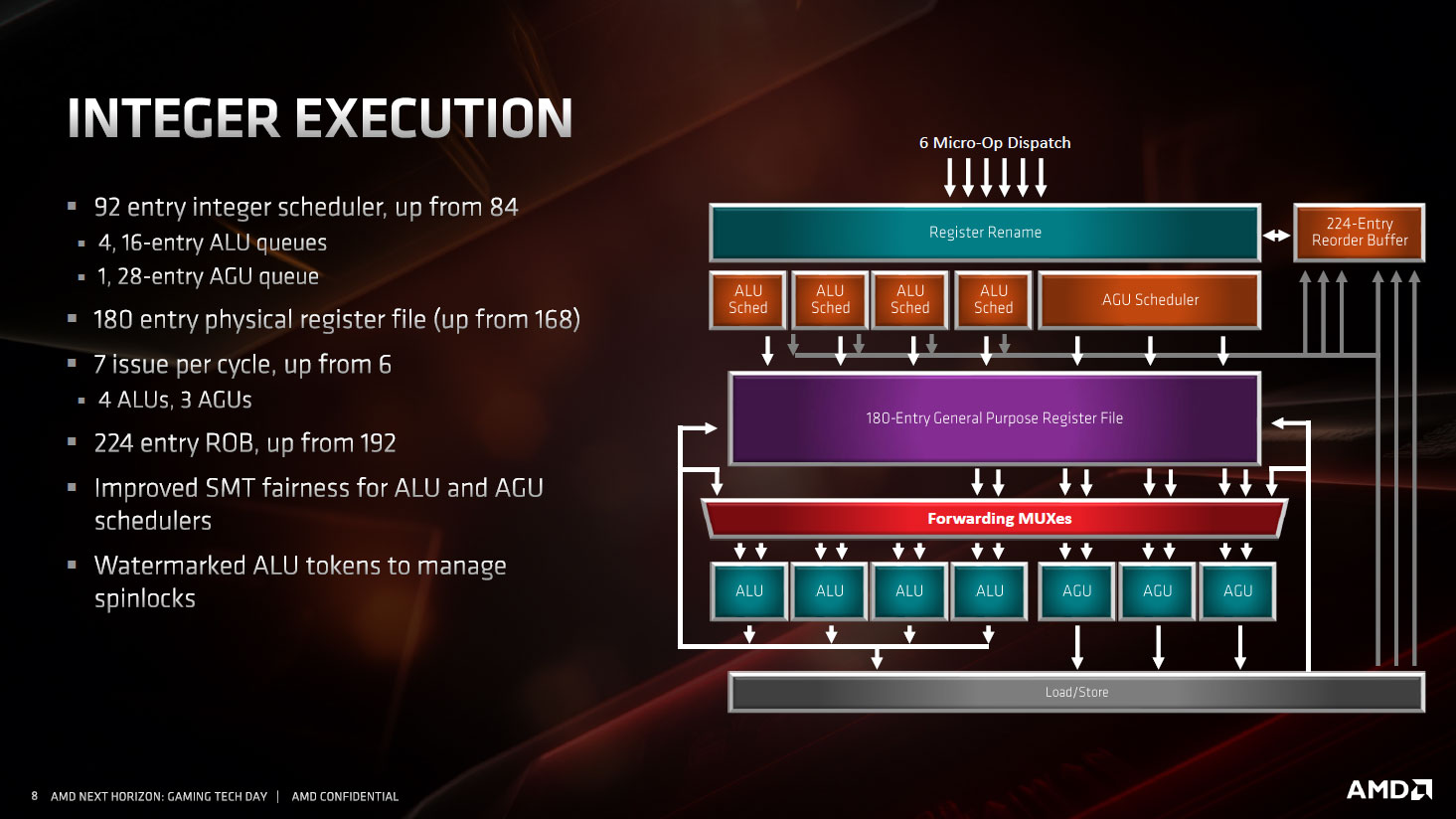
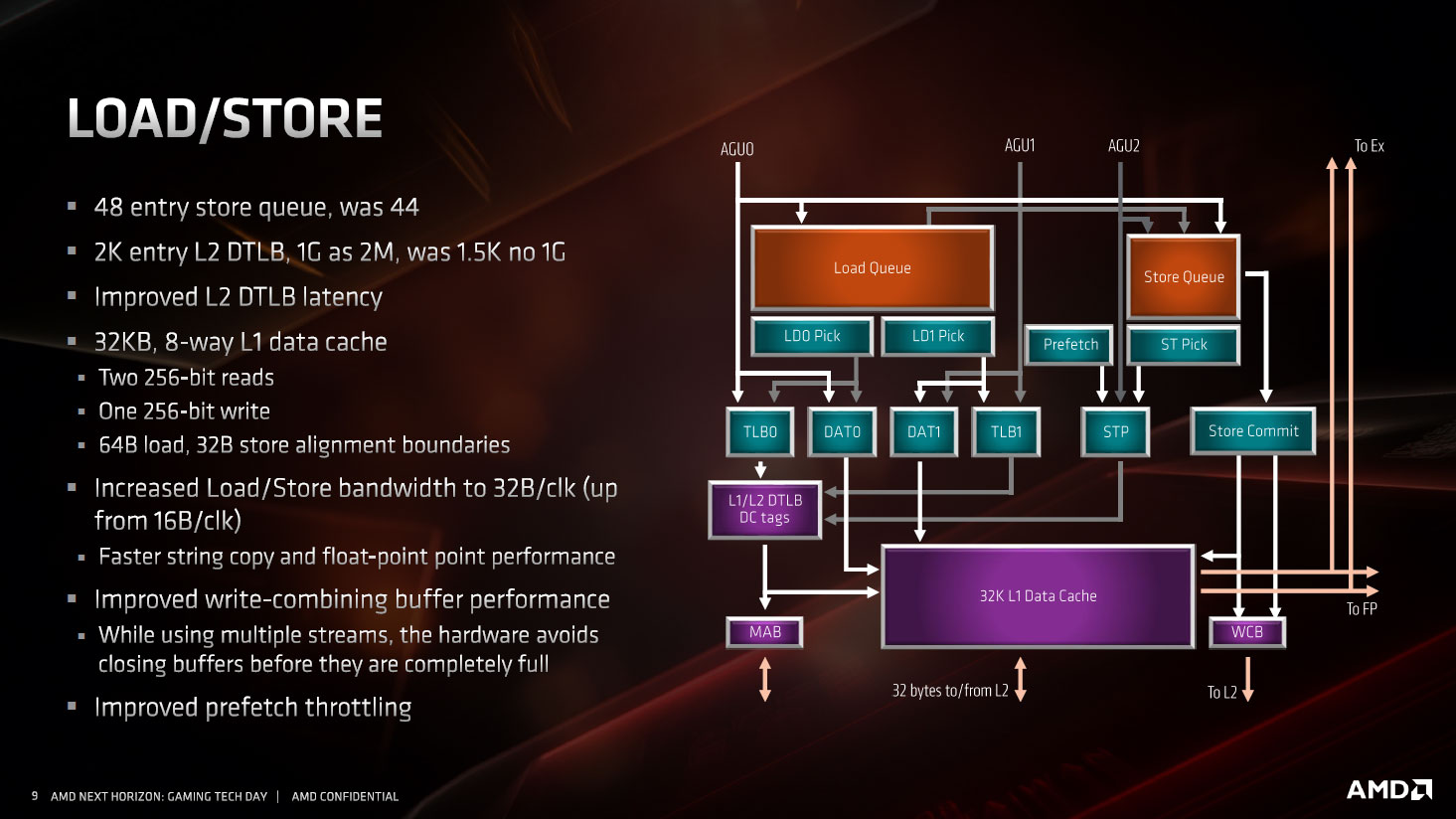
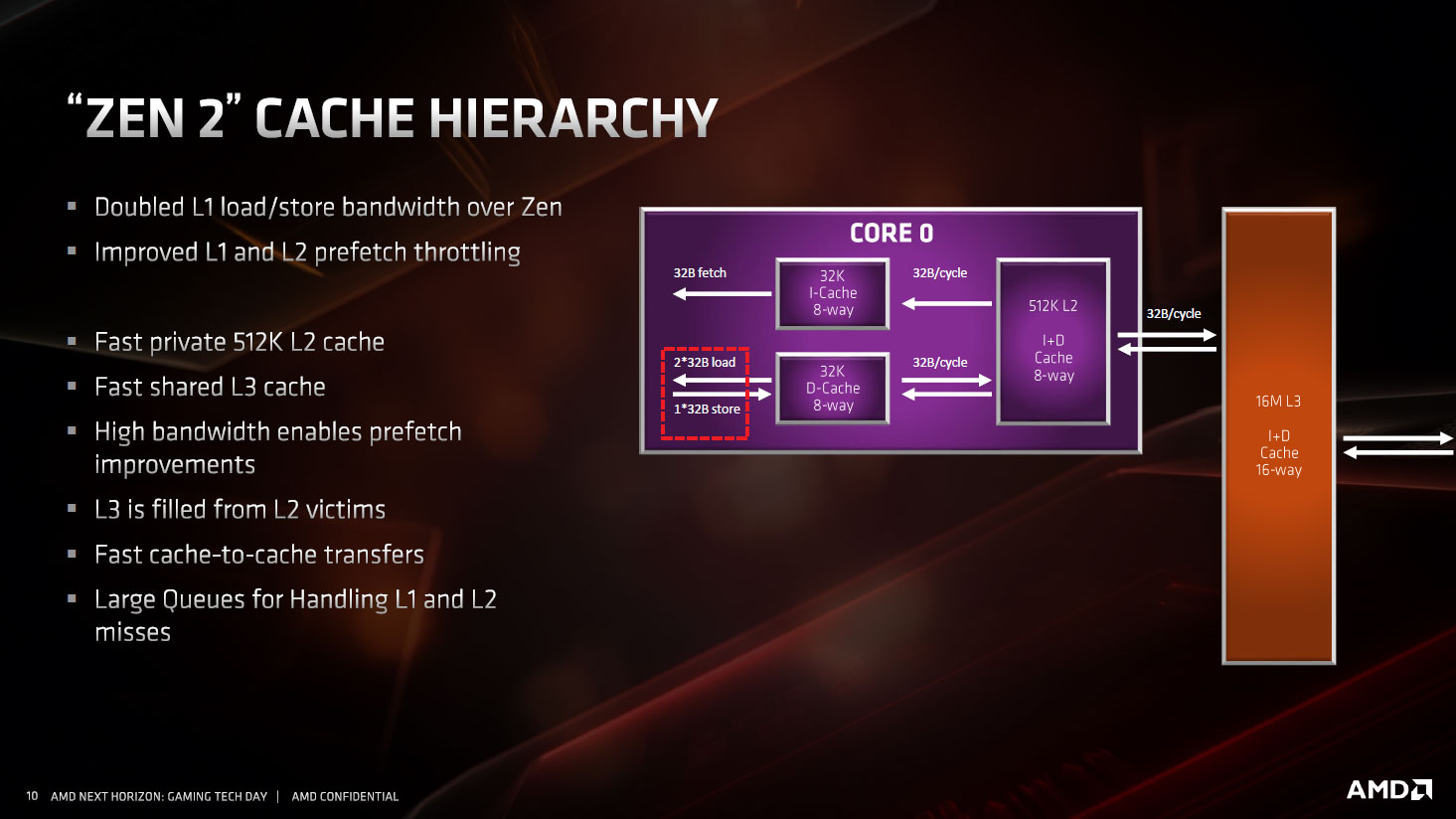


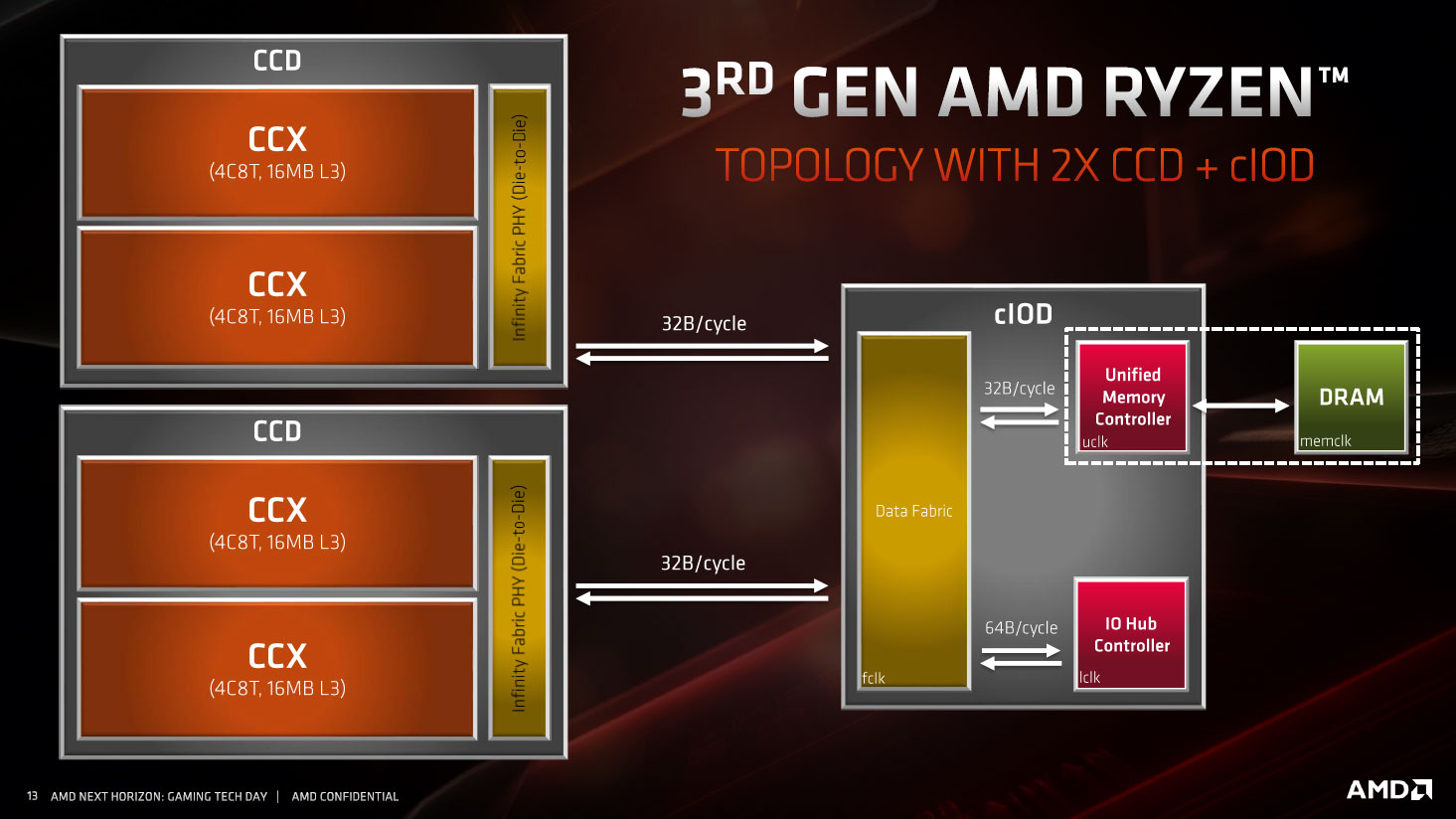
The Zen 2 architecture
Zen 2 is more than just a die shrink—a switch to the smaller 7nm manufacturing process. Smaller process nodes typically mean better power efficiency, potentially higher clockspeeds, and improved density—or more transistors in the same size chip. All of those benefits appear to be part of the Ryzen 3000 processors, but there's a lot more going on underneath the hood. At a high level, AMD claims IPC (Instructions Per Clock) is 15 percent higher than Zen+. That means for the same number of cores and the same clockspeed, Zen 2 should be 15 percent faster. But how did AMD get that 15 percent improvement? It's all in the architectural details.
I already mentioned one major change with the Zen 2 design, moving the memory controller into a separate IO chip. This has a latency penalty compared to previous Ryzen CPUs, but it has the benefit of not creating substantially different memory latencies when moving to a dual chiplet design like Ryzen 9. But that memory latency increase ends up being mostly a moot point according to AMD, thanks to the other architectural changes.
One big update is the doubling of the L3 cache size. On the single chiplet Ryzen 5/7 parts, there's a 32MB victim cache—meaning, data in the L2 cache doesn't get replicated into the L3 cache (an exclusive cache if you prefer). The dual chiplet Ryzen 9 CPUs meanwhile come with a combined 64MB L3 cache. Because of the exclusive caching design, AMD adds the L2 and L3 cache sizes and calls this the Gaming Cache. With 512KB of L2 cache per core, that gives the 6-core Ryzen 5 chips 35MB of Gaming Cache, 36MB of Gaming Cache for the 8-core Ryzen 7 parts, the 12-core has 70MB of Gaming Cache, and the big daddy 16-core 3950X has 72MB of Gaming Cache.
And what do those massive cache sizes do for memory latency? AMD says on average the effective memory latency is reduced by 33ns relative to Zen+, which in turn can improve performance by up to 21 percent—and that's in games. The larger L3 cache sizes do cause a slight increase in cache latency—typical L3 cache latency is now 40-45 cycles compared to 35-40 cycles on Zen—but compared to the roughly 200 cycle latency of system memory the benefits should be substantial. And if you're keeping track, L1 cache latency is still 4 cycles and L2 cache latency is 12 cycles.
Going along with the larger caches, AMD has added a new TAGE branch predictor in Zen 2. There's a whole lot of technical detail we could get into, but fundamentally incorrect branch predictions can cause a pretty big performance hit—the 19-stage pipeline gets flushed and restarted, so every branch miss is a major opportunity for performance improvements. Zen 2 keeps the Perceptron branch predictor for the L1 cache (which already works well), but adds the more complex TAGE branch predictor for the L2 cache. The net result is that AMD says Zen 2 will make 30 percent fewer incorrect branch predictions.

In the execution units, AMD also added a third AGU (Address Generation Unit). That gives Zen 2 seven execution ports, but it can still only dispatch up to six instructions per clock. However, there are enough cases where the CPU could use another AGU that it apparently made sense.
Another change is to the floating point (FP) performance, with AMD doubling the AVX performance. Where Zen and Zen+ had a two cycle latency for AVX256 instructions, Zen 2 is single cycle. There's a related change to the load and store bandwidth, which is now 256 bits wide instead of 128 bits. Also, multiplication latency is three cycles, down from four cycles. This may not affect all workloads that much, but for applications that utilize AVX2, the gains should be pretty substantial.
Something not quite as directly applicable to the CPU architecture is Zen 2's support for PCIe 4.0. That doubles the bandwidth between the CPU and chipset, as well as the M.2 slot. It should also boost the bandwidth between the CCDs and the cIOD within the package, since those Infinity Fabric links are presumably PCIe 4.0 derived as well. What PCIe 4.0 means in the real world is less clear. SSDs that support the new standard are coming, and will deliver even higher throughput than existing M.2 NVMe SSDs. But for gaming purposes, neither the GPU nor the storage is likely to matter much.
There are plenty of other tweaks in Zen 2—a larger 4K micro-Op cache, larger 180 entry register rename space (up from 168), increased L1/L2 BTB tables (512 L1 vs. 256, 7K L2 vs. 4K), moving from a 64K 4-way associated L1 cache to a 32K 8-way L1 cache, a 224 reorder buffer (vs. 192), and more. That's all highly technical stuff that you need to be a microprocessor engineer to properly appreciate, but the bottom line is that Zen 2 ends up being better than Zen/Zen+ in just about every way.
How much better? I'll get to AMD's claims in a moment, but one interesting point that came out of discussions with AMD's CPU experts is that even though the theoretical maximum IPC of Zen 2 is 6.0—if it filled every possible instruction dispatch every cycle—in the real world most applications are only getting an IPC of about 1.5. There are more predictable workloads where IPC might be as high as 3.0, other complex workloads where IPC drops as low as 0.25, but on average Zen 2 is getting 1.5. The larger caches, improved branch prediction, extra AGU, larger buffers, and other architectural changes are all ways of improving IPC.
AMD Ryzen 3000 performance
AMD is setting expectations quite high with Zen 2, claiming an average 15 percent IPC improvement relative to Zen+. That 15 percent improvement comes from all the above architectural updates, and combined with higher clockspeeds and core counts, performance should be a significant step up from the Ryzen 2000 series. But it's not just about the hardware, as there are some software changes that will also play a role.
One of the big problems AMD has faced with its Ryzen and Threadripper CPUs is that Windows simply doesn't have a great process scheduler when it comes to designs like Zen/Zen+/Zen 2. Specifically, L3 cache latency is worse on the AM4 processors when a thread is running on one CCX (Core CompleX—a group of four CPU cores along with their caches and other bits) and accesses data stored in the L3 cache on the other CCX. This increases memory latency, and it would be better if threads from the same application were grouped on the same CCX when possible.
The Windows 10 May 2019 update improves on the Windows scheduler, and combined with a new AMD chipset driver (which isn't available to the public yet), thread scheduling should be better. This could improve performance by 5-10 percent in some workloads, and it will be available for all Ryzen and Threadripper platforms by the time the new CPUs launch. What isn't clear is how much of the performance increases AMD showed in its slides will come just from the Zen 2 architecture, and how much comes from the new scheduler, but I'll look into it more once I have CPUs in hand.
Intel has made some bold statements about performance, going so far as to say "come beat us in gaming if you can." I'll have full independent numbers in the coming weeks, but as of now, I can provide both information on where AMD and Intel currently stand, as well as AMD's performance information for several Ryzen 3000 CPUs. If AMD's slides are accurate, Intel may regret that challenge.
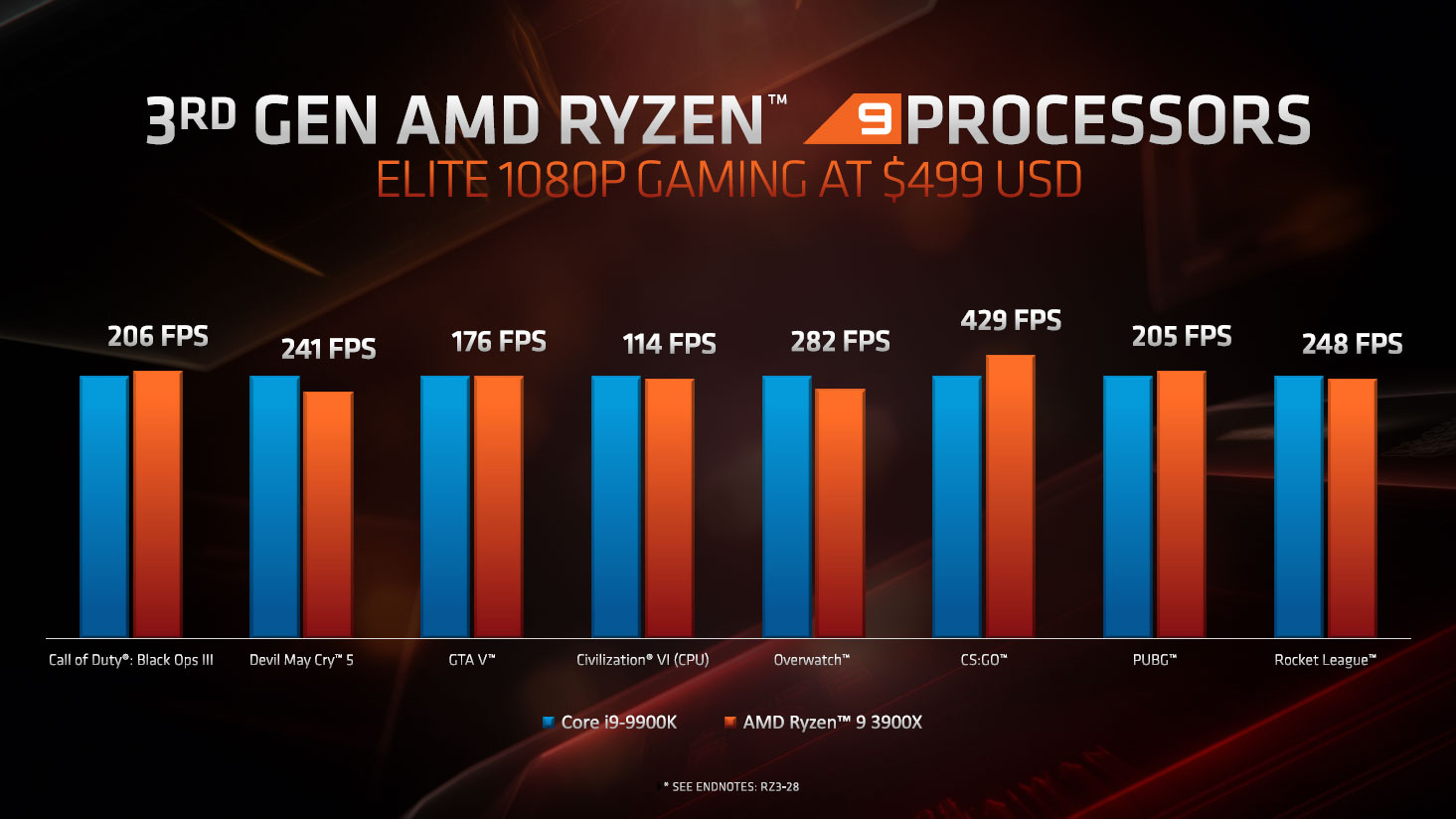
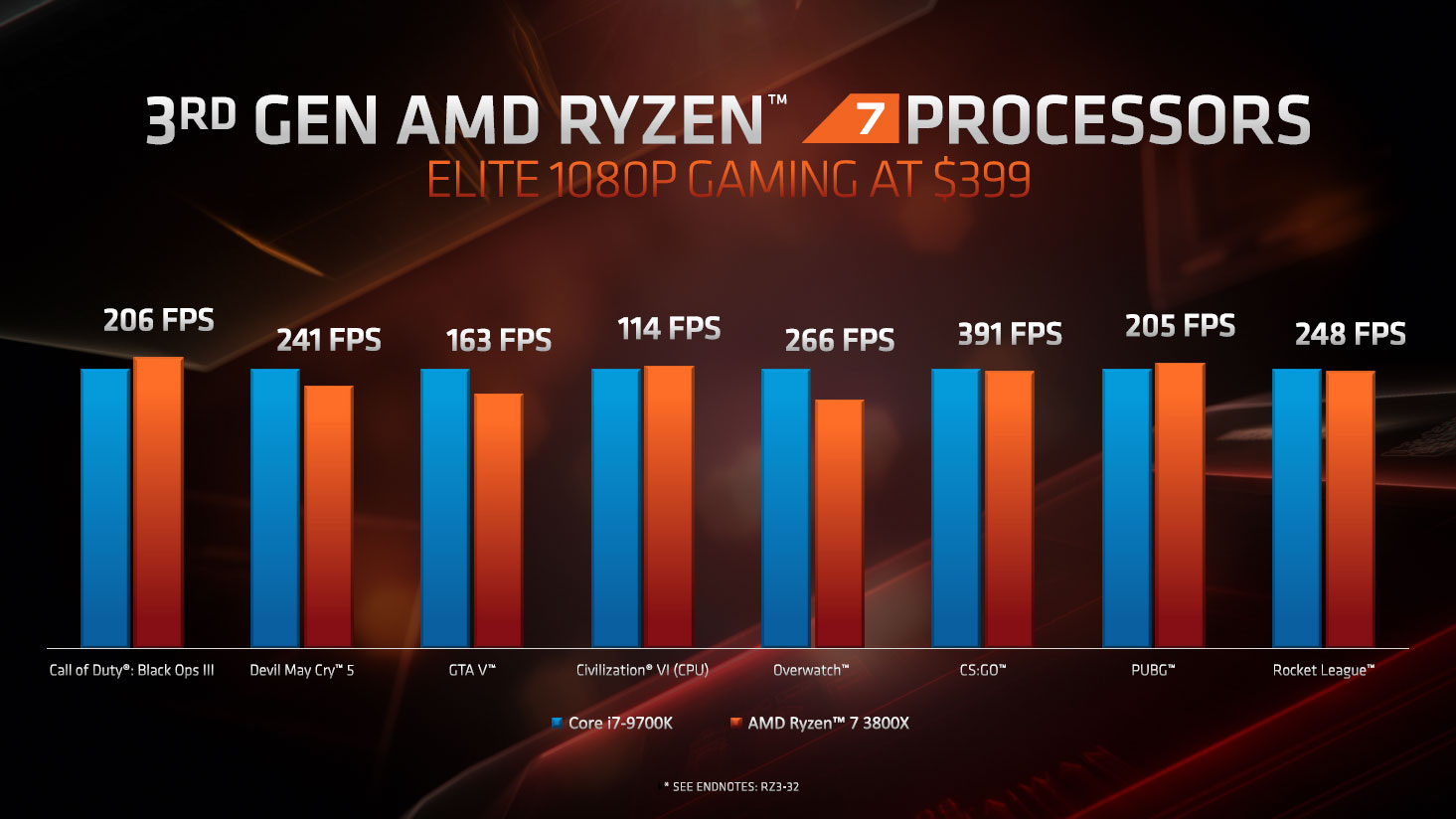

Starting with the Core i9-9900K against the Ryzen 9 3900X, across eight games AMD is showing relatively equivalent performance. The same goes for the Core i7-9700K versus the Ryzen 7 3800X, and the Core i5-9600K going up against the Ryzen 5 3600X. AMD performed all of these gaming tests at 1080p high settings, where the CPU is more likely to make a difference, and the graphics card used is an RTX 2080. That last point is important, as if you're using a slower GPU like an RX 580 or GTX 1060, you'd see far less of a difference. Unfortunately, AMD didn't provide hard numbers for both the AMD and Intel CPUs, so all I can say is that the results look relatively similar.
Let me put that into context, however. I've been retesting all of the modern Intel and AMD CPUs in advance of the Ryzen 3000 launch, using an RTX 2080 Ti and testing at 1080p ultra. With ten different games (Assassin's Creed Odyssey, The Division 2, Far Cry 5, Fortnite, Hitman 2, Metro Exodus, Middle-Earth: Shadow of War, Shadow of the Tomb Raider, Strange Brigade, and Total War: Warhammer 2), I can say that the fastest gaming CPU in my results right now is the Core i7-9700K, which just edges out the Core i9-9900K—141.0 fps compared to 139.4 fps. The Core i5-9600K incidentally gets 131.4 fps.
More important than the i9 vs. i7 vs. i5 Intel comparison is the Intel vs. AMD Ryzen comparison. The Ryzen 7 2700X averages 118.1 fps and the Ryzen 5 2600X gets 116.8 fps, so Intel leads by 19 percent on average, and the Core i5 leads by 12.5 percent. Looking at the individual games, Strange Brigade is AMD's best result—it's a tie among basically all five CPUs—while Far Cry 5, Hitman 2, and Shadow of War have Intel leading by 30-45 percent in some cases.
What we don't know is exactly where the Ryzen 3000 CPUs will land relative to these processors. However, with a claimed 15 percent IPC improvement and slightly higher clockspeeds, plus larger caches that in some cases might result in even larger gaming performance improvements (AMD showed up to 30 percent improvements relative to the 2700X in another comparison), things could change. AMD's Ryzen 9 3900X and Ryzen 7 3800X in particular could potentially end up as the best processors for gaming and other tasks come July.
Will AMD claim an outright lead in gaming performance? Perhaps not. However, with 12-core going up against 8-core, 8-core/16-thread going up against 8-core/8-thread, and 6-core/12-thread squaring off against 6-core/6-thread, the non-gaming matchups look to be decidedly in favor of AMD. Perhaps that's why Intel is talking smack about games?
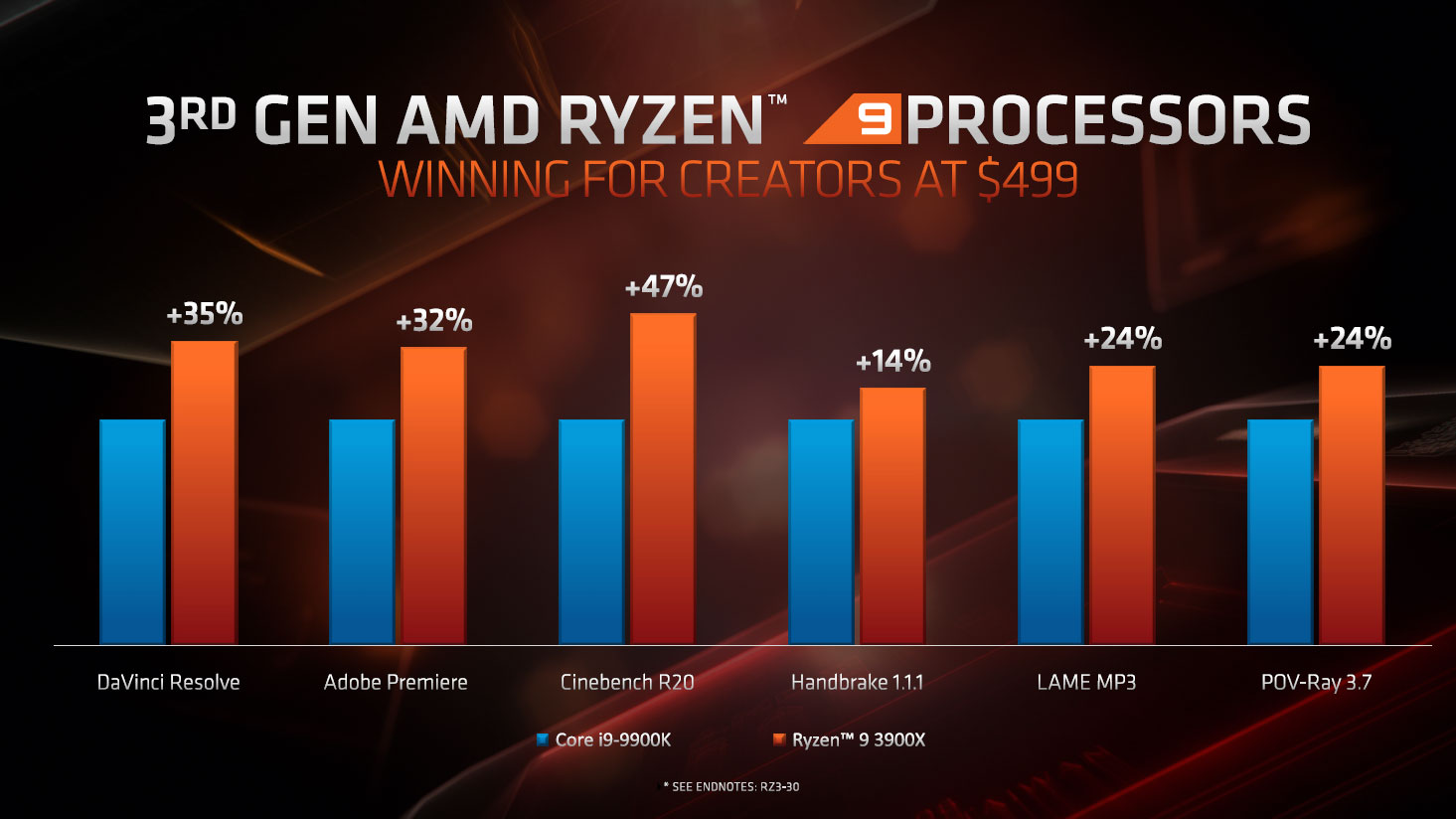

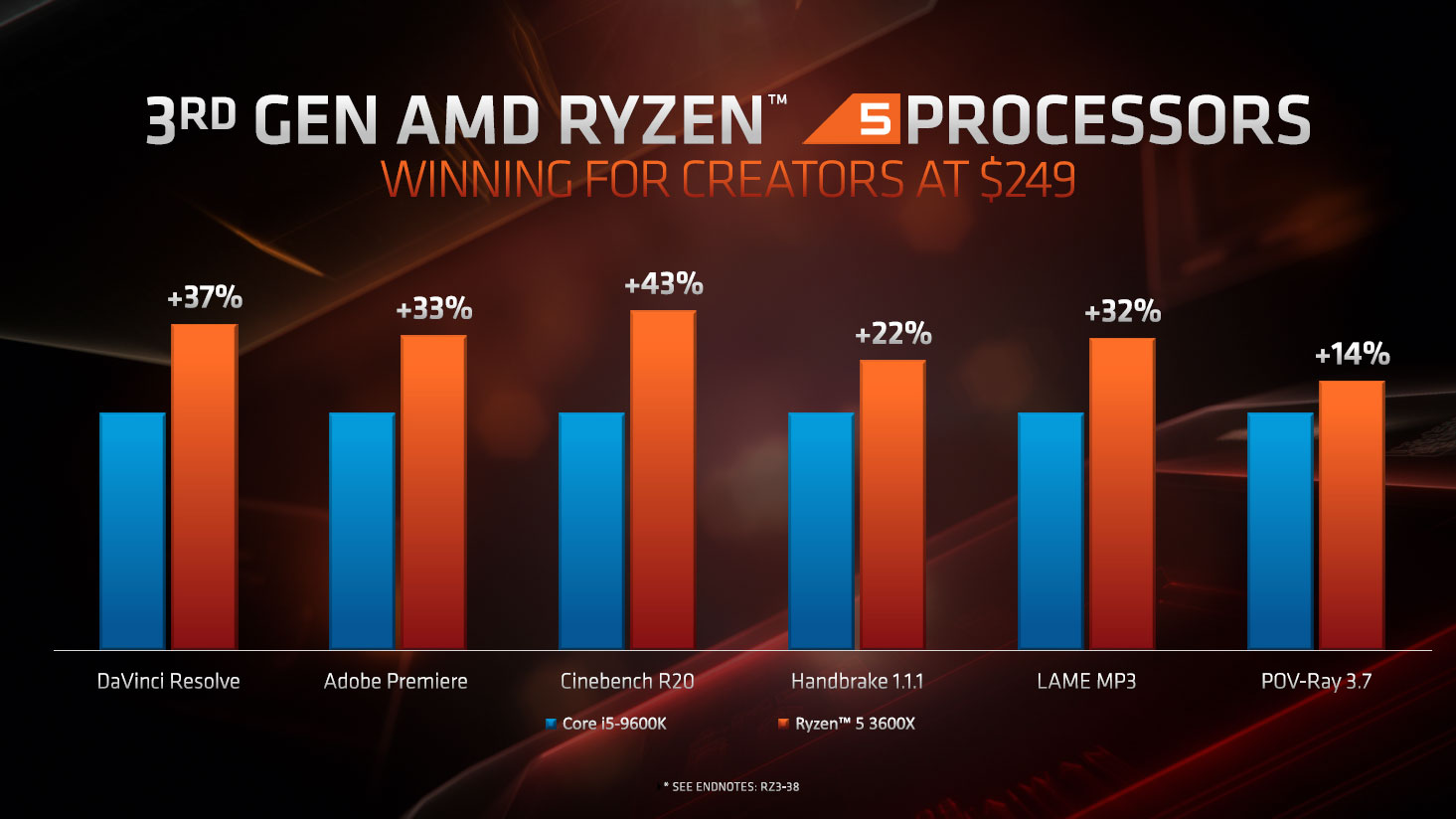
These non-gaming results from AMD all support the above statements. With relatively similar clockspeeds and IPC on both AMD and Intel CPUs, having 50 percent more cores/threads—or even twice as many cores/threads—guarantees AMD will win every meaningful multithreaded performance comparison. Cinebench, POV-Ray, Blender, H.264 encoding, H.265 encoding, cryptography, and more should all favor AMD's Ryzen 3000. Even singlethreaded performance looks close, based on what AMD showed (which may not be representative of all workloads).
Keep in mind that a lot of consumers really don't do much in the way of heavily multithreaded workloads. Cinebench, POV-Ray, Blender, and other 3D rendering applications are popular CPU benchmarks, in part because they're easy to run. Outside of professionals, few people use such applications. About the most complex task a typical consumer would perform is video encoding, like when livestreaming gameplay. Otherwise, for non-professional work the need for more than an 8-core CPU is debatable.
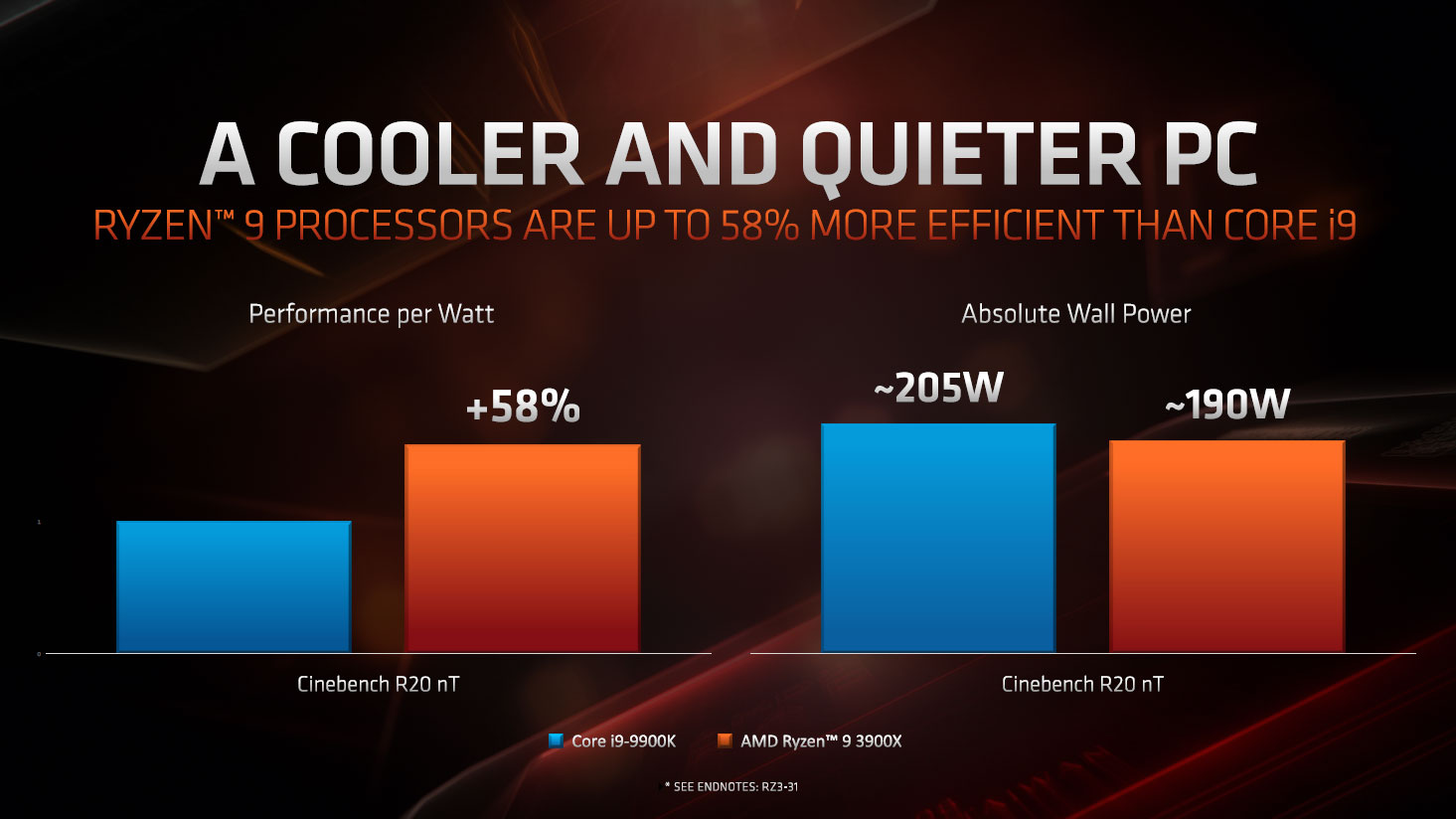
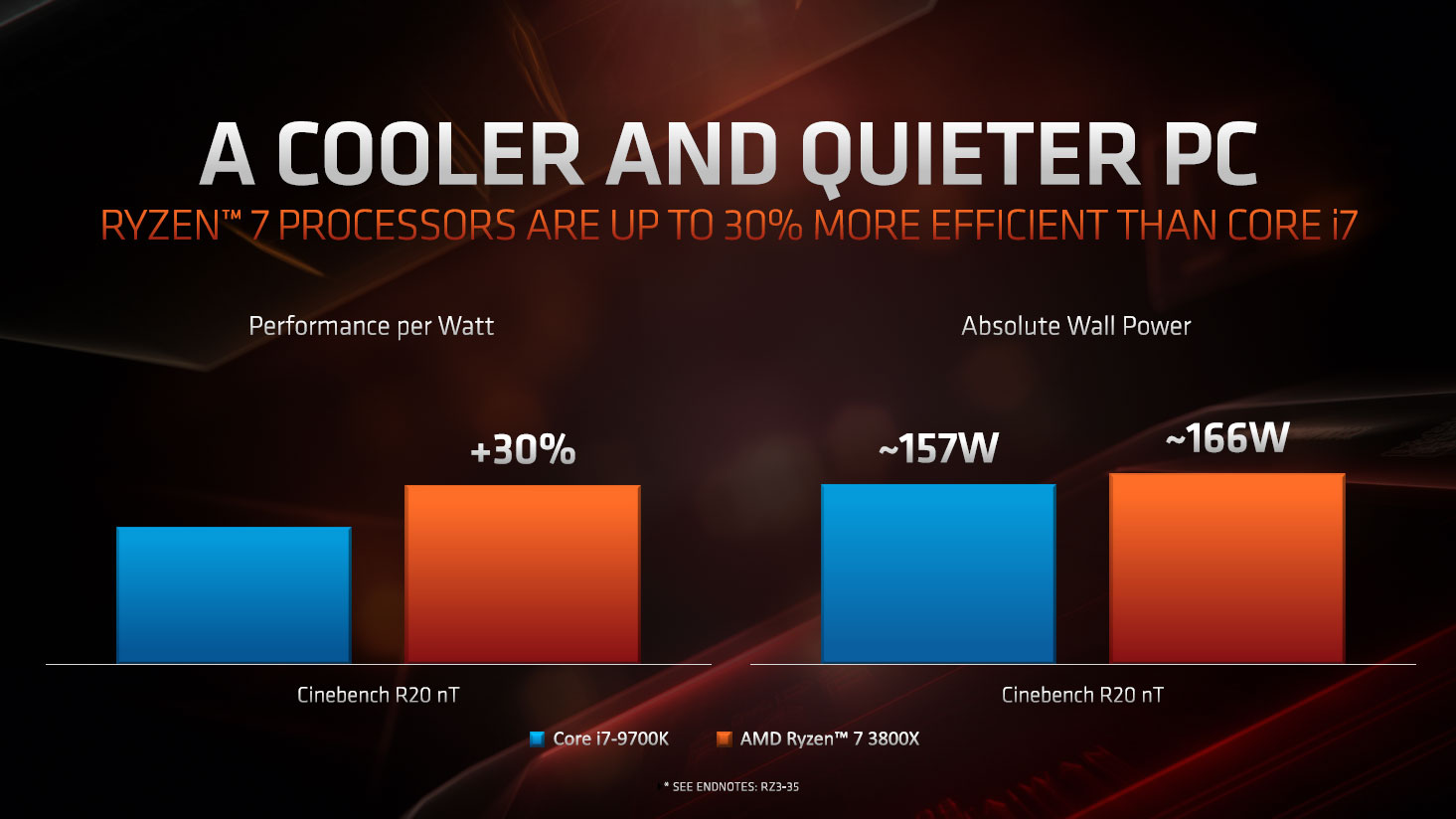
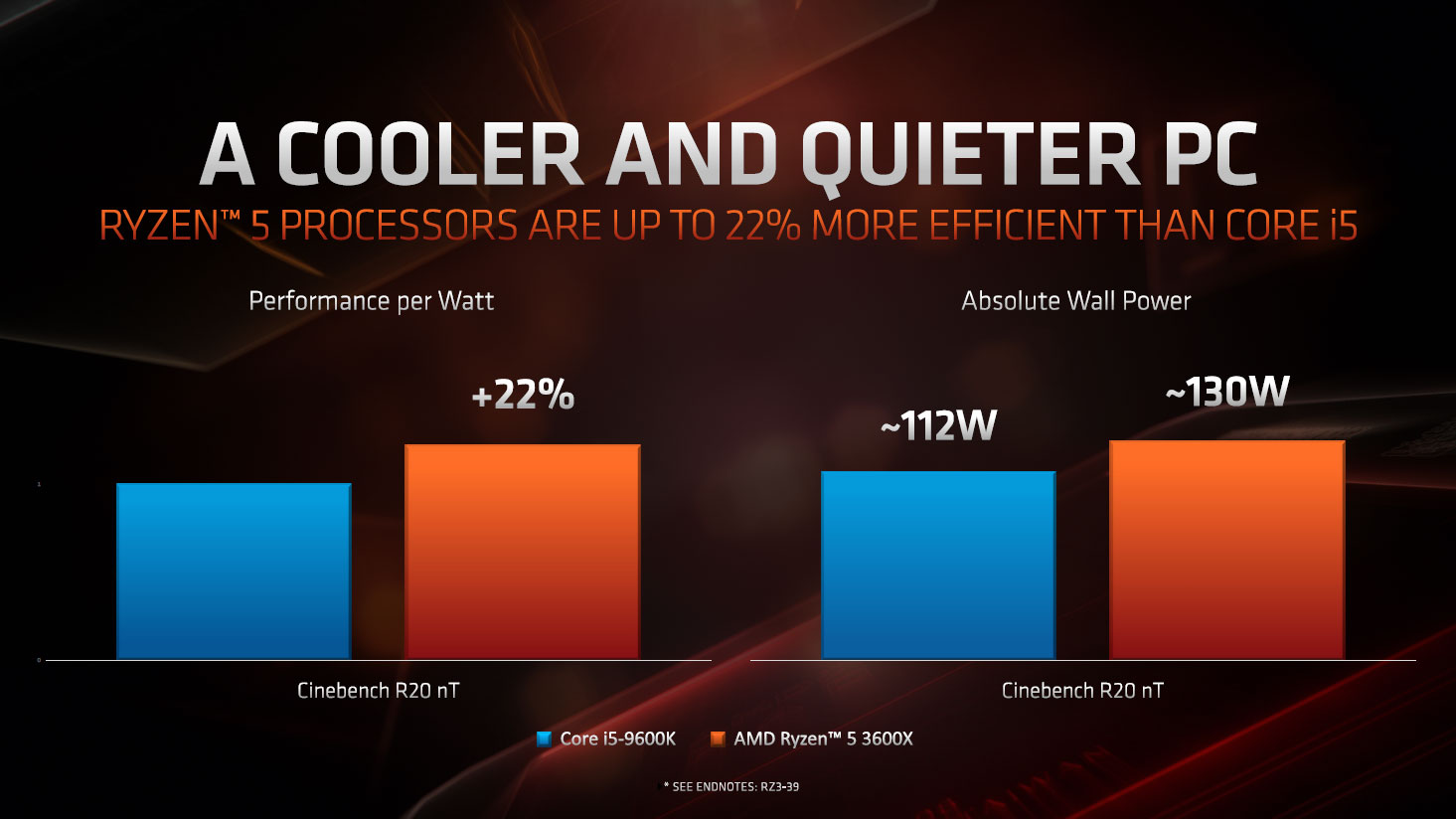
More telling is the TDPs of AMD's parts. Both the 12-core and 16-core Ryzen 9 parts are supposed to be 105W parts. Whether they'll fully respect that power limit or the motherboard manufacturers will "boost" performance and run at higher clocks is not yet clear. Intel's CPUs certainly run well beyond their rated TDP in some workloads, and with the 7nm process AMD's new chips should come out in the lead on power.
Something else to point out here is that Intel's Skylake-X processors look absolutely terrible in terms of efficiency compared to Zen 2, or even the Coffee Lake refresh. I've seen 10-core Skylake-X (i9-7900X) pull as much as 300W for a CPU heavy workload at "stock." Performance can be good in the right scenarios, but it's using far more power than I'd like. The i9-7980XE carries things even further, with peak CPU loads reaching as high as 450W. That's nearly double what I see on the mainstream AM4 and LGA1151 platforms.
When is the Ryzen 3000 release date?
All of AMD's Ryzen 3000 and Radeon 5700 products are set to launch on July 7, 2019. That's a shoutout to the 7nm technology at the heart of the products. As far as review embargoes and independent performance testing, that could come sooner, but officially AMD hasn't given a date yet. Sometime in the next few weeks, we'll have the full reviews posted for most of the new CPUs, but the 3950X won't arrive until September. Let the official countdown to launch commence.
Paul has been playing PC games and raking his knuckles on computer hardware since the Commodore 64. He does not have any tattoos, but thinks it would be cool to get one that reads LOAD"*",8,1. In his off time, he rides motorcycles and wrestles alligators (only one of those is true).


